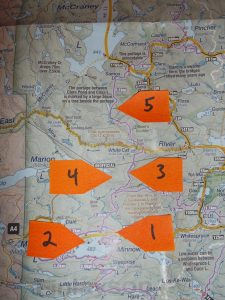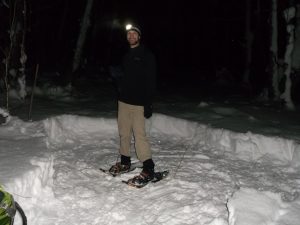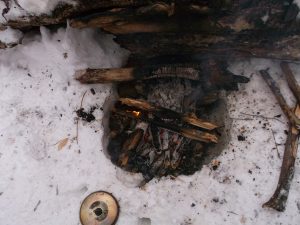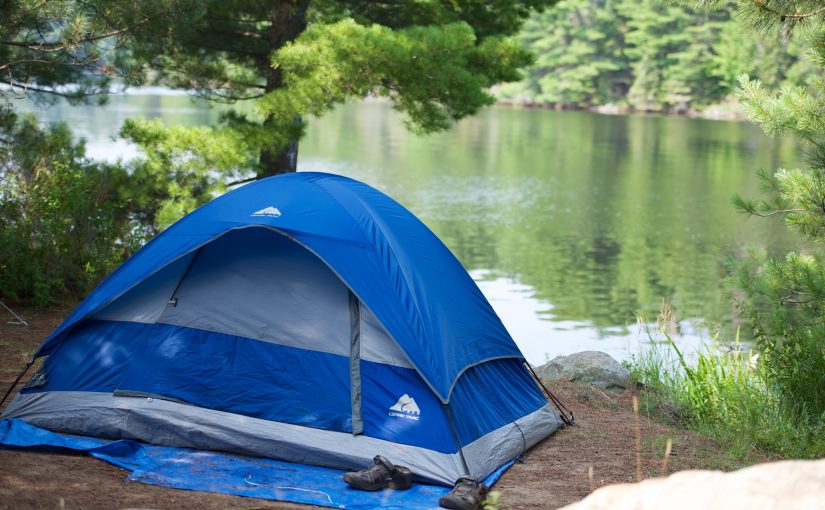So you’re thinking of going winter camping for the first time. You’ve packed the thermal underwear, bought/rented the snowshoes, picked the perfect brand of hand warmers, and are thinking ahead to setting up camp. Although most of the summer camping principles apply in winter too, there are several winter-specific factors to consider.
Note: Although many of the principles below apply to trips where you set up a base camp for multiple days, I prefer treks that progress from point-to-point, so this post will not focus on the use of a heavy winter tent with an installed stove (“hot tent”).
Picking a campsite
 As in the other three seasons, picking a site near (unfrozen) water will save a lot of time and effort. Melting snow is always an option, but there is a reason that Antarctic explorers consider it a chore to be avoided. Although lakes present a reliable source of water, you’ll likely have to chop/drill through ice. Instead, consider looking for flowing streams or rivers, which will provide easier access to the water. Wind can make a cold night even worse, so also consider looking for topographical features (valleys, gullies, hills) that can serve as wind breaks. Camping right on the lake can provide great views, but also increases your wind exposure.
As in the other three seasons, picking a site near (unfrozen) water will save a lot of time and effort. Melting snow is always an option, but there is a reason that Antarctic explorers consider it a chore to be avoided. Although lakes present a reliable source of water, you’ll likely have to chop/drill through ice. Instead, consider looking for flowing streams or rivers, which will provide easier access to the water. Wind can make a cold night even worse, so also consider looking for topographical features (valleys, gullies, hills) that can serve as wind breaks. Camping right on the lake can provide great views, but also increases your wind exposure.
Tip: A top-notch map with topographical and water features can let you identify and locate the perfect site ahead of time. Sites 1, 3, and 5 in the picture are ideal: they have easy access to a nearby river (which will not have frozen), are at a relatively low elevation (vs. the surrounding area), and are not excessively exposed to wind. Site 2 is nice during the summer, but has no wind protection in the winter, and being in the middle of the lake will mean drilling for water or melting snow. Site 4 is also exposed to wind (top of a hill), and has no ready access to running water.
Setting up your tent
My favourite part of winter camping is the absence of roots and bumps under your tent. When camping on snow, a flat surface can be created with about 15–20 minutes of walking around in circles. This time can be used to cool down and let your base layer breathe, while using the moderate activity to not get too cold. Don’t forget to pack down paths to your cooking/fire area, water source, food hang, and sanitation area (more on this later).

If you have the time/energy, consider building up a low wall around the footprint for your tent, as this can provide an extra layer of wind protection. Once you have a suitable footprint for the tent, it’s time to throw down (the tent). Your standard tent pegs won’t work well in snow, but you can buy specialized snow pegs ($2–5/each), or notched sections of thick branches can also be used. If you are willing to carry the extra weight, a tarp placed in the vestibule will provide a place to change in/out of your boots without getting too much snow in them.
Tip: Try to pack the snow to a density that will allow you to walk on it without snowshoes; it feels great to walk around in boots after a day of snowshoeing.
Let there be FIRE!
If you’ve spent any time at all in the backwoods, there’s a good chance you have minor pyromaniac tendencies. The great thing about winter is the complete absence of burn bans, so if you can find it, you can burn it. However, finding wood is easier said than done when there is >2 ft. of snow on the ground. Although it’s tempting to just hack down the nearest tree, the park wardens and Mother Nature won’t be impressed. In addition, deadfall invariably burns cleaner, so stick to scavenging for wood. In the winter bigger is always better, so look for larger branches or small fallen trees that provide a longer burn time (provided you have a hatchet). In my experience, a diameter of ~2 in. will provide a good burn time without needing to spend hours splitting the wood; don’t forget to collect enough wood for the next morning!
Tip: I never leave for a trek without my walking staff, and it can be extremely useful for probing around in deep snow to identify fallen wood that has been covered in snow.

Once you have the wood, take a second to think about where you want to set up your fire pit. The fire will burn through the snow, so look for places where you can dig down to the ground. Large rocks or logs provide an opportunity to act as both a wind-block and heat reflector, so poke around in the snow and see what you can find. Any fire is good in the winter, but a fire whose heat is directed out in one direction can be a major pick-me-up for cold toes and hands. When building the fire, start with a small teepee to start, and place the larger pieces of wood around the fire to melt off the extra snow and ice. A large piece of aluminum foil is a standard part of my gear kit [hyperlink to Gear post], which can double as a wind shield or heat reflector.
Picking a spot for sanitation
Although winter camping allows you to camp essentially anywhere on the trail, this means you may not have a nearby thunder box. Therefore, you may need to select a spot for “doing your business”. As in the other months, make sure this location is well away from water and the trail (>200 ft.), and preferably downhill from the trail or campsite. However, once you have selected a location, be sure to pack down a trail to/from your campsite. Nothing ruins a morning like having to strap snowshoes on/off before making your morning ablutions.
Tip: As with the fire, a log or rock to lean against may make the task at hand slightly more comfortable.
Optional extras
Although it’s winter, and the bears are hibernating, a food hang is still an important part of making a clean and safe camp. I’m a big fan of freeze-dried dinners in the winter, but afterwards the bag is covered in food, and is a prime target for foxes and other small rodents that are looking for an easy meal. Look for a tree with an easily accessible branch, and pre-hoist your rope while you’re waiting for dinner to cook. There’s no need to hang your food >10 ft. in the air, as 4–5 ft. is sufficient to keep the little critters out, although safe is better than sorry in the shoulder seasons (late fall/early spring) when bears may still be active.
Have a little extra time to kill, or want to make your site especially comfortable? Consider packing down the snow around your campfire hole and making snow furniture! Digging through 2–3 ft. of snow with your snowshoes sounds like a pain, but this can provide a useful wind-break and comfortable place to relax. A simple bench is all that’s necessary, and your tarp or pack cover [hyperlink to Gear post] can provide a waterproof layer if your pants aren’t waterproofed. Alternatively, your snow shoes can also be used as a flat surface to sit or lean on.
Also check out these useful articles about Winter Camping
Getting started in Winter Camping
Algonquin’s Mew Lake: A great choice for first-time winter campers
By Patrick Mott
Patrick Mott is a professional medical writer/editor, and a part-time gear and adrenaline junky who loves to pack light and push boundaries in the backwoods.



Leave a Reply